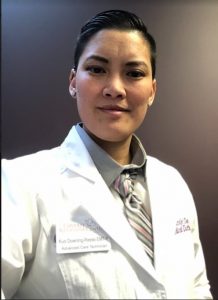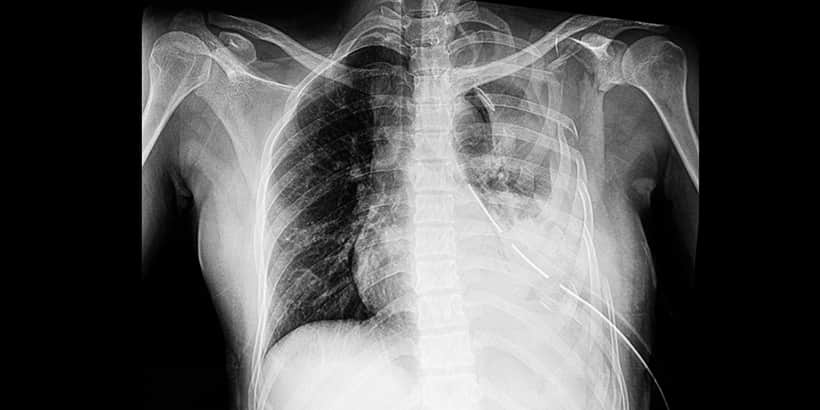How to Recognize and Stop Human Trafficking in EMS
 You and your partner are dispatched to respond to a 911 call for a female with abdominal pain. When you arrive, you are met at the door by a gentleman who appears to be in his mid-40s. He takes you to a bedroom toward the back of the home where you find a young, teenaged female who is laying in bed in obvious distress. The man goes on to say that his wife has abdominal pain that started last night but has become increasingly worse.
You and your partner are dispatched to respond to a 911 call for a female with abdominal pain. When you arrive, you are met at the door by a gentleman who appears to be in his mid-40s. He takes you to a bedroom toward the back of the home where you find a young, teenaged female who is laying in bed in obvious distress. The man goes on to say that his wife has abdominal pain that started last night but has become increasingly worse.
As you begin your assessment, you start to ask some basic questions to try to assess the patient’s complaint of abdominal pain. Each time you ask a question, the man quickly answers for the patient. You ask politely if he could let her answer the questions and he agrees, but he begins to answer her questions again. From what you can determine, the patient appears to have lower right abdominal pain. Since the man stated that he and the patient are married, you assume the patient is likely to be sexually active and you begin asking questions regarding her last menstrual period. The man states it was a week ago and that she uses contraceptives. The patient has never been pregnant.
You decide to transport the patient to the nearest emergency room and the male on scene questions you repeatedly about why the patient needs to go to the emergency room and why you cannot just give her something for the pain. You explain that the abdominal pain could be a surgical problem and that to determine the need for surgery, the patient may need exams and tests that can only be done at the hospital. The male finally agrees, and you load the patient onto the stretcher and into the ambulance. The gentleman tries to step into the back with you and the patient stating he needs to be with his wife. You tell him that company policy forbids extra passengers to ride in the patient compartment and that he can either drive his own vehicle or sit up front in the cab of the ambulance. He very reluctantly sits in the front.
Once in the back of the ambulance with the patient, you begin your physical exam. You find that she has multiple bruises in different stages of healing, but she seems to have a story for each bruise. She explains she is very clumsy. She fell down the other day, hitting her side. She bumped into a piece of furniture. You notice she doesn’t really make eye contact with you. She’s quiet, almost to the point where you must strain to hear her answers. You suspect that her explanations are not true but do not press much further. You arrive at the hospital and give your report. After the call, your partner and you discuss how weird the man and woman were and how it seems so odd that they are married when she is so young.
Have you ever experienced a call like the one described above? Do you think there was something you may have missed and was there anything else you could have done for the patient? The above story is just one example of a person who may be a victim of human trafficking. Yet, how does a provider know for sure if a person is a victim? Are there common signs that a first responder can look for when they suspect a person might be a victim of some sort of illegal activity? This article will discuss what we can do as first responders as well as our legal obligations.
Human Trafficking Defined
First, lets us define what human trafficking is exactly before we discuss how EMS and first responders can identify, treat, and assist these patients. There may be some confusion that human trafficking is just the transportation of people across government borders illegally. Money may be exchanged, but many times services are used as payment. The person being moved is normally being held against their will and being forced to work or provide sexual acts in order to try to gain freedom or they risk injury or even death for themselves or their loved ones. According to the Department of Homeland Security, human trafficking can be defined as the use of force, fraud, or coercion to exploit human beings (children and adults) for some type of labor or commercial sex purpose. Domestic slavery, sex trafficking, forced or bonded labor, and forced marriage are all forms of human trafficking. Each has its own dangers and risks, and some have focused targets, such as young girls ages 12-14.
Domestic Slavery
Domestic slavery is when a person is forced to work with little to no wages and is forbidden to leave. Most times the person is brought to a private home. The domestic worker generally performs tasks such as cooking, cleaning, laundry, and taking care of children or elderly in the home. They are “at work” around the clock and are many times kept in subpar living conditions. “Wages” can be in the form of food or accommodations, and the domestic laborer is often threatened with violence or threats of violence.
These workers are often ostracized from their families and friends. Threats may be taken against their family, such as work, or your family will be beaten, or their home destroyed. Some laborers will have their identification taken away from them so they have no proof of identity or citizenship. Without such paperwork, the person is unable to find honest work or leave their captors. Most domestic slaves are primarily young females, some younger than 16 years old. While many of these domestic workers are brought into the country illegally, there are national labor laws that do protect them to some degree.
Sex Trafficking
Sex trafficking is defined as a person who is forced to work for commercial sex purposes. This can include sexual exploitation in the forms of pornography, prostitution, or sexual performance in exchange for money, drugs, food, or shelter. It is considered one of the fastest-growing crimes in the world. Once again, the prime target is generally children, both male and female, between the ages of 14-16 years old.
Homeless teens and gay or lesbian youth have frequently been exploited by sex traffickers since they already have a strained relationship with their families and/or do not always realize what is happening. Some common misconceptions are that the person must be taken across international borders; however, to meet the definition of human trafficking a person must only be exploited by coercion or deceit. Confusion between prostitution and sex trafficking is another misconception. While the two can be one and the same, they can also be very different. If a person decides to sell their body in exchange for money, drugs, clothes, etc. but are not forced to do so by any other person and/or persons, then they are not a victim of human trafficking. It is not until an outside person or persons forces the other person to perform such acts that it becomes an act of human trafficking.
Forced or Bonded Labor
Forced or bonded labor is like domestic labor except that the person forced to work is often trying to pay off some type of debt. For this reason, forced or bonded labor is sometimes referred to as debt bondage. Generally, the person is forced to work for very little wages, and most if not all the money earned goes into paying a debt they have no control over. It is not uncommon for the debt to be so large that several generations are forced to work as bonded laborers in order to pay a loan taken out decades ago. This type of labor once again targets women and girls but even men can find themselves a victim of this type of human trafficking. Whole families may find themselves working extremely long hours for very little wages and one uncontrollable event could result in the need of a loan, adding to the debt owed and tying this family to labor for years to decades in hopes of paying off their debt.
Forced Marriage
Lastly, forced marriage can be defined as when a woman or child is forced to marry another person against their will and without their consent. A large age difference is seen in many of these situations. A girl as young as 12 may be forced to marry a man 3 times her age. She is far too young to be able to provide for herself alone, so she is forced to stay with her husband. In a forced marriage, similar to forced slavery or domestic labor, the individual is forced into marriage by another person, usually the parents or other legal guardian. In the United States, duress, threat, physical abuse, and death threats by any family member constitutes force and coercion. Therefore, a person married due to any of the above meets the legal definition of human trafficking.
Recognizing Signs of Human Trafficking

So why is it so important for EMS and first responders to be aware of human trafficking? As first responders, we may be the first outside person to have any interaction with a person who has been forced or coerced to work. The type of interactions we might have with them may provide key clues to identifying these victims, if we know what to look for during these encounters.
During a physical exam, do you find signs of abuse? Maybe you find bruising in various stages of healing suggesting injury or trauma that occurs over a longer period or multiple times. The patient may also show signs of malnutrition and appear underweight. They may be too embarrassed or scared to try to ask for help. It would not be uncommon for the person who is forcing or exploiting the patient to be hesitant to leave you alone with the patient. Often, they will try to answer any questions you ask, not letting the patient say anything for themselves. At times, language or cultural barriers will keep the patient from communicating with you. They may appear very shy or submissive. They may even flinch when you motion toward them. You might see them constantly checking in with their abuser or waiting for their cues before they speak or move. It would also not be uncommon for the aggressor to try to seek for treat and release. Meaning, they wish for you to treat the patient or stabilize them and then refuse transport to the hospital.
Healthcare providers can play a huge role in finding and rescuing victims of human trafficking, but its not always a black-or-white situation. It may not be readily obvious if the provider does not look for the signs.
EMS is one of very few professions where one is invited into a person’s intimate space. The patient’s home may be opened for you to enter, and during a true emergency you have an up-close view of the living situation and circumstances. Delicate medical information is shared, and you are entrusted with the care of the person seeking medical assistance. However, unlike most patient’s, a victim of human trafficking may provide you with very little information. They may answer with one-word answers or with nothing at all. Perhaps there is one person who seems to always answer for the patient, never letting them get a chance to say anything. Maybe they seem to almost leer over your patient and you. This may start raising some red flags for you. The patient is often seen as a possession or a source of income. The human trafficker does not want the opportunity to have such an asset taken away. They will always want to be in close contact.
Perhaps you are called to a job site where you find a patient injured. Were they not given the proper protective equipment or safety gear? Were conditions otherwise unsafe, like working in hot conditions with no air conditioning or fans? Is the patient unwilling to answer questions on how they were injured? Do they keep changing the subject or seem hesitant to discuss the circumstances of how they were injured? These might be clues of forced or bonded labor.
Human Trafficking Stats and Demographics
The idea that victims of human trafficking will only be found in dark, dank, filthy inner-city apartment buildings or trailer parks is far from the truth. Human trafficking occurs across the nation and in every socioeconomic group. Young teens across the United States have found themselves easy prey with the ease of access to the internet. Survivors of human trafficking have described situations where their accused spent months setting up the perfect scenario. They prey on naïve young minds and lure them with promises of money, romance, support—whatever the teen is looking for to convince them to meet up with the trafficker. They build a trusting relationship under the disguise of promises. The average age of a person who is forced into trafficking for sex is between 12 and 14 years old.
At least 55% of victims are women and children and it affects over 45 million people worldwide. Rich and poor alike are at risk, and EMS providers may have to look closely at the dynamic relationship between the victim and the person exploiting the patient to see the clues. Research shows that the majority of human trafficking survivors had some sort of contact with a medical provider at some point during their ordeal. This is an important fact to remember.
In a study done by the Annals of Health Law, it was found that 88% of persons who were forced into sex trafficking had seen a healthcare professional and nearly 97% were never given information or resources regarding human trafficking while they were with the provider. It is important to not only provide care but a safe outlet for these patients. They may be embarrassed or scared to discuss why they are there. One clue could be the number of sexual partners they have had. Is there bruising or signs of force near their genital areas or over their wrists and ankles?
Always provide care without judgement. Try to remain open-minded. Discreetly provide information on human sex trafficking and offer helpful resources. There are times the victim doesn’t understand they are a victim and education is the first step toward escape. If you simply approach that type of patient asking if they are a victim they might not understand your question or that there is help if they want it and they are not in trouble. Whenever possible, without drawing too much attention, try to exam this type of patient in private. If you can get alone with the patient, they may be more willing to speak.
What to Do If You Suspect Human Trafficking
The EMS professional should first and foremost treat the medical or trauma condition the patient is suffering from. Regular treatment protocols should be followed. If, during the patient exam or assessment, the medical provider begins to suspect that their patient may be a victim of human trafficking, it will be important for the EMS provider to follow through with reporting their suspicions. Perhaps they found a number tattooed on the patient. Many victims of human trafficking have been tattooed with numbers used to identify them to their captors. Some were so young when they were taken that they don’t even know their real names, date of births, etc. Any real form of identification is usually taken by the person in control to keep the victim from leaving. Without proof of identification, the victim is unable to gain lawful employment elsewhere or even prove their legal identity to others. The trafficker knows this and uses this as a way of forcing their will, making sure the victim knows that they are helpless without them and that they have no way to financially provide for themselves without the trafficker.
Again, bruising found in different stages of healing suggest physical abuse. Sure, there are many other reasons why a person could have bruising. Perhaps the person is an athlete in a contact sport. Maybe they have an underlying medical condition that requires injections daily, like some blood thinner treatments. The important thing to remember as a medical provider is to obtain a thorough medical history. Does the explanation seem plausible? Does the story match the type of injury? For instance, a spiral fracture that tends to happen with forceful twisting might not be adequately explained with a story of a clumsy person who simply fell. Regardless of the injury or medical complaint, is there someone on scene who seems very adamant that the patient does not need transport? Do they seem unreasonable? Do they want what is best for the patient or for themselves? It is important that you as the medical provider, perhaps the only other person this patient will see, are able to “read between the lines” and alert the right resources.
So what resources are there for you as the first responder? Of course, local law enforcement should remain top of your mind. Can you alert the police while being discreet? Obviously, if the trafficker catches you there is a real danger to not only your patient but to you as well. One of the first things we are taught as EMS professionals is BSI (body substance isolation) and scene safety. We are taught early on if a scene is not safe, do not enter. In this instance, you are already on scene. Do you leave?
Almost every national or local group invested in human trafficking would advise that you not confront a suspected trafficker directly. Instead, if you are able to get law enforcement there quietly, then do so. If you are not able to, try your best to act natural. If you must leave the scene and even the patient to get away safely do so, and then notify the police. There are several different numbers and organizations you can call:
- You can call the Department of Homeland Security’s toll-free number 1(888)347-2423 if you believe you have information regarding human trafficking.
- You can also text the Department of Homeland Security using 233733 (BeFree). If you send a text to that number with the message HELP or INFO, it will connect you with someone from Homeland Security. This may be an easier option than making a direct phone call in front of a person of interest who you feel may be violent.
- You can also call for federal law enforcement at 1(866)347-2423. These numbers all go to a person who is trained in human trafficking and can provide you with information on what steps you should follow next.
The overall goal of the EMS provider should be to learn how to recognize signs of human trafficking and know how to effectively report it when you suspect your patient may be a victim. With appropriate training and awareness, an emergency medical provider can become an integral part of the support system these victims need to escape their abusive situation. Understanding the myths and the confusion surrounding human trafficking is important to remember.
Human trafficking can affect rich or poor, young and old. While there are certain groups or demographics who are more at risk, it is extremely important to understand that anyone is vulnerable and, as a medical provider, you may be the only safe way for the person to escape. Treatment should be focused on caring for the chief complaint, but there should also be patient advocacy that focuses on reporting the suspicion or informing the patient of their options. There is a need to provide more than just medical care but also provide emotional and psychological care as well. Most of these victims/patients have endured significant trauma. This may affect how the patient behaves and responds. Building a trust relationship will be very important in order to get the victim to open up to you. Creating a safe environment will be a key factor in the success of helping this patient.
Additional Resources
The Blue Campaign is headed by the Department of Homeland Security and raises public awareness regarding human trafficking and what to look for, how to recognize indicators, and how to properly respond to possible cases. There are plenty of training materials available to help your organization learn more about human trafficking and how to appropriately respond if an encounter occurs while you are at work.
The Polaris Project is another well-known organization that focuses on human trafficking. For over a decade they have been providing valuable information and countless dedicated hours of work in their fight to end human trafficking of any kind.
Besides the Blue Campaign and the Polaris Project, there are a multitude of organizations around the nation who work tirelessly to end the abuse and trauma suffered by those who become victim to human trafficking. Look for resources in your local community or state so you can be prepared if you come across a patient you suspect is a victim of human trafficking.
References:
Amato V. Hidden in Plain Sight. EMS World. April 2019. www.emsworld.com/article/1222435/hidden-plain-sight.
Bender R. How EMS providers can identify a victim of human trafficking. EMS1. January 2016. www.ems1.com/human-trafficking/articles/how-ems-providers-can-identify-a-victim-of-human-trafficking-UbEGCN7khPkLmebN/.
Department of Homeland Security Strategy to Combat Human Trafficking, the Importation of Goods Produced with Forced Labor, and Child Sexual Exploitation. Department of Homeland Security. www.dhs.gov/BlueCampaign.
Donnelly E, Oehme K, Barris D, Melvin R. What Do EMS Professionals Know about Human Trafficking? An Exploratory Study. Journal of Human Trafficking. 2019:5:4, 325-335, DOI: 10.1080/23322705.2018.1501258
EMS’s Role to End Human Trafficking. EMS.gov. www.ems.gov/newsletter/marapr2016/end-human-trafficking.html.
Human Trafficking. Polaris Project. www.polarisproject.org/human-trafficking/
McConnell S. Make a Difference: EMS and Human Trafficking. American Ambulance Association. April 2018. www.ambulance.org/2018/04/11/make-a-difference-EMS-and-human-trafficking/.
Training helps EMS workers identify human trafficking signs. U.S. Fire Administration. November 2018. www.usfa.fema.gov/current_events/110818.html.
 Kuo Downing-Reese is a 16-year veteran of EMS. She started her career in Los Angeles County in a variety of settings, including private ambulance, fire, and hospital ED. Kuo went to paramedic school at UCLA-Daniel Freeman. She has a degree in EMS management from George Washington University and currently practices as a full-time critical care paramedic in Rochester, New York. She also does a variety of EMS and medical training as a NYS Certified Lab Instructor (CIC intern), NAEMT instructor, and as AHA regional/training center faculty.
Kuo Downing-Reese is a 16-year veteran of EMS. She started her career in Los Angeles County in a variety of settings, including private ambulance, fire, and hospital ED. Kuo went to paramedic school at UCLA-Daniel Freeman. She has a degree in EMS management from George Washington University and currently practices as a full-time critical care paramedic in Rochester, New York. She also does a variety of EMS and medical training as a NYS Certified Lab Instructor (CIC intern), NAEMT instructor, and as AHA regional/training center faculty.



